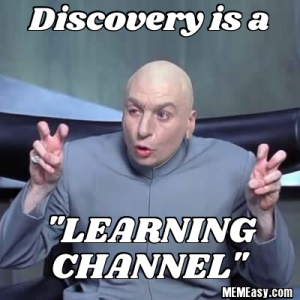PART 2 – Consulting U: The Rundown On IT Consulting
6 Chapter 6: Discovery Phase

WHAT Discovery means
The Discovery phase sets the landscape of your project in way. This is when you’ll be finding a suitable client, determining an appropriate project, and as Arrk Group says, “when you will work alongside your team in an effort to establish a deep understanding of what [the] expectations of the project really are.”[1] Remember all of that baselining, goal setting, and sizing up discussed in Chapters 2 and 3? All that wonderful stuff happens right here in the discovery phase.
WHEN Discovery Happens
For students who will commence the Capstone course in the fall, this phase will take place during the summer months before the course start. Discovery activities will often be the starting point whether using a waterfall or agile project management process. However, since this phase entails the most rudimentary elements of your project, it’s not something you’ll necessary want to cycle through several times. The Discovery phase is what kickstarts everything else. Nobody wants to look for another client or project after they’ve been secured already, right?!
WHO Discovery Involves
Simply, it involves your team and potential client stakeholders. As you go through the process described in Chapter 3, you may in fact interact with many possible clients as your team decides on who will be the most suitable one to pursue the Capstone project with.
WHY The Discovery Phase Is Important
Since this phase is the very thing that kickstarts your project, it’s important to start off on the right foot. It’s the starting point on which you’ll build the foundation of your project. We all know what happens when you try to build a house on quicksand!
HOW to Navigate Through Discovery
While voyaging through the Discovery phase, your focus will be on two key objectives:
- Find a suitable client
- Find an appropriate project of interest
As a group, use your network of contacts (ex. professionals you have connected with at networking events, your manager from a co-op internship, professors, family members, or friends) to find a company that would be a suitable client for the project. While it may be a scary task, know that over 400 companies have partnered with students on the Capstone project over the last 10 years. Be encouraged by the fact that countless companies want to be involved and are eager to see the benefits your project can bring as a result of agreeing to partner with your team. Refer to Chapter 3 and the many resources available in Chapters 19-20 to help guide your conversation along with potential clients.
Once you find yourself a suitable client, start to identity the things you need to understand, such as the industry, client background, and the problem you may need to solve. Identify the key contact (and secondary contact!) you will have at the company and their availability. When possible, get to know the culture and environment in the company and how they work in these early stages. Know where the company is located and where you’ll possibly be commuting to for meetings. This could dictate how you approach your work.
The more information you can draw from initial conversations with the company, the better you will be prepared for future phases. It is important during this phase to be assessing whether or not this will be a suitable client relationship. Look for red flags that may determine the client may not be ideal, such as lack of response from stakeholders or lack of willingness to share information. Set yourself up for a win by ensuring open communication with the client (more on that in Chapter 13), including getting appropriate permissions to access data which will allow your team permission to analyze and problem solve.
The second objective of this phase is to find a project topic or opportunity of interest for the group to focus on. An ideal project topic is a problem area or an inefficient process that can be improved by leveraging technology to deliver value to the company. Use your research of the company and industry and leverage conversations to understand the client and their key business processes, problems, and areas of opportunity. As a team, be conscious of the important questions that you need to be asking and the data you should be requesting. Just when you think you’ve asked the last question, find another one to ask.
To help generate the understanding you require of the company, here are examples of information and data that you can collect about a company, both publicly available and available by request.
Typically available online:
- Company history
- Vision statement
- Mission statement
- Financial reports
- Press releases/public announcements
- Customer ratings and reviews
- Shipping and return policies
Ask your client for:
- Financials
- Key performance indicators
- Process metrics
- Inventory records
- Process maps
- Organizational chart for the department you’re looking at
- System manuals
- Reports on strategic initiatives
- Documentation on user tasks/process flows
- Arrk Group. (2018). The Importance Of Getting The Discovery Phase Right. Retrieved from https://www.arrkgroup.com/thought-leadership/the-importance-of-getting-the-discovery-phase-right/ ↵


Feedback/Errata